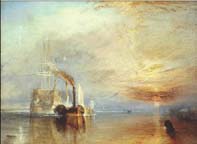The painting On The Esk, Whitby by John Grimshaw depicts a small fishing port at either dusk or dawn, wrapped in a serene mist. The water is calm, small lights twinkle in the background while in the foreground a solitary figure works at something indistinguishable. The emotions evoked by the painting are largely a result of Grimshaw's expert use of light and shadow. As a later Pre-Raphaelite, Grimshaw carried elements of that heritage, and of artists like J. M. W. Turner. However, their influence did not stop him from developing a unique style

The Pre-Raphaelites employed bright, even light that allowed for full depiction of details. Turner, by contrast, was more in line with traditional schools of painting. His use of a very direct light source and high contrast theoretically fit with the conventions of the time, but more often than not the light itself was the focus of his paintings, not merely a way to illuminate his subjects. Grimshaw manages to incorporate both elements into his landscapes. His light usage is much more even than that of Turner, and his scenes more photorealistic, less fantastical, much more Pre-Raphaelite. However, light also takes an active role in his paintings
Discussion Questions
Grimshaw shows an image of the developed world, a fishing port, and yet has only one barely distinguishable figure present to hint at the presence of humanity. Ergo, the moodiness of the painting is much more a result of absence, of a time of day when the majority of society is tucked away. In doing this, does he find a way to create a peace of sorts between the natural and the unnatural? Does humanity seem less invasive?
In having a direct backlight, Grimshaw reverses one of the typical trends of painting — that of having the foreground illuminated and allowing the background to blur and darken, creating an illusion of depth. How does his less conventional silhouette technique also manage to create a sweeping vision?


Compare this work by Grmshaw with two of Turner's most famous paintings, Calais Pier: An English Packet Boat Arrivin and The Fighting Temeraire tugged to her last Berth to be Broken up, 1838. All three use light as a means of amplifying meaning, and all three have relatively subject matter — the interaction of sea, sky, and humanity. Explore where exactly they diverge, and where they're similar. Are two of them more of a kind than another?
Many of Grimshaw's landscapes have similarly subtle, solitary figures somewhere in the middle ground. What's the significance of placing a figure in such a way?
Last modified 11 April 2007